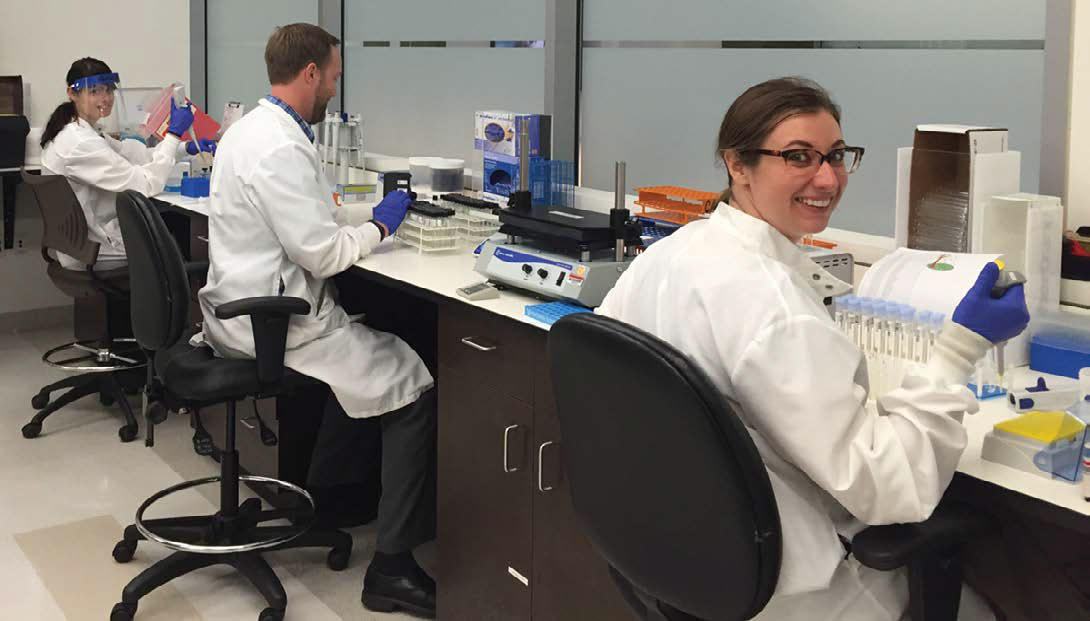Keywords:
Testosterone levels are typically determined using automated immunoassay analyzers, but this has limitations. Liquid chromatography-tandem mass spectrometry (LC-MSMS) offers a selective and accurate alternative, and the Center for Advanced Laboratory Medicine at the University of California San Diego is using a novel extraction technology to automate sample preparation for this technique.

Automation helps eliminate tedious manual pipetting
The University of California San Diego Center for Advanced Laboratory Medicine (UCSD-CALM) uses state-ofthe- art technologies to provide diagnostic medicine and pathology services, as well as developing new diagnostic assays for therapeutic applications. Mass spectrometry (MS) is an important analytical tool in the laboratory, but the challenge is developing and validating reliable, reproducible sample preparation methods suited to a clinical setting. Judy Stone, Senior CLS Specialist in the Toxicology Laboratory, explained: “I’ve been working with MS for about 25 years, initially with gas chromatographymass spectrometry. More recently, the focus has been on LC-MSMS. This has become the technique of choice for many applications, with laboratories developing and validating new methods for testing patient samples.”
Judy continued: “Reliable, accurate results must also be cost effective to be useful for patient care. In terms of materials, analytes such as testosterone can often be measured at a lower cost using LC-MSMS compared to an automated immunoassay analyzer. However, the trade-off is that LC-MSMS is labor intensive; sample preparation involves a great deal of pipetting, and there is always concern about the risk of mixing up samples. In addition, there are ergonomic considerations associated with manual processes. Automating sample preparation on a liquid handling workstation can help with these issues.”
"With cleaner extracted samples, instruments need maintenance less often, minimizing unplanned downtime and sample backlogs"
“I was working at another laboratory when Tecan launched the AC Extraction Plate™ for MS sample preparation. I tried it, and found it so simple to use; I just manually pipetted the samples into the plate and used the existing instrument parameters, and it worked the first time, which was very impressive. However, we had just invested a huge amount of time and resources in validating a different sample preparation method and, as this process was almost complete, it simply wasn’t realistic to change direction at that point.”
“When I moved to UCSD-CALM, I approached Tecan about doing some collaborative studies using a Freedom EVO® workstation and the AC Extraction Plate, starting with testosterone analysis. Most clinical laboratories do these tests on an automated immunoassay instrument, which works well for samples from men with normal testosterone levels, but is not always the best technique for samples from women, children or men with low serum testosterone. LC-MSMS offers better accuracy and selectivity, but robust and reliable preparation of large sample numbers is difficult using manual liquid-liquid extraction. This process can be tedious and hard to automate, and requires some expertise to use routinely with acceptable performance. In contrast, the AC Extraction Plate is extremely simple, requiring just a plate shaker and accurate pipetting, which can be reproducibly performed by the Freedom EVO. We can prepare a batch of samples on the liquid handling platform with as little as 15 minutes of hands-on time, or from start to finish in about 90 minutes, which is a significant labor savings. Manual preparation can take from 30 minutes of hands-on time for a small batch to two and a half hours for larger numbers of samples. The results after using the AC Extraction Plate for sample preparation were so reproducible during validation that we are considering whether we actually need to run a full set of 11 calibration standards with each batch of samples. If comparable results can be obtained with just two standards per batch – the highest and lowest concentration calibrators – or using a standard curve from another day updated with a couple of key calibrators, this is a clear benefi t to the laboratory. We are retrospectively studying our data to see if this is viable, and it looks very promising so far.”
“Ultimately, our goal is to increase both our test menu and the number of samples performed per test on a daily basis. We already perform 25-hydroxyvitamin D testing by mass spectrometry, and plan to automate the manual pipetting steps of this process on the Freedom EVO in the future. We are also developing an AC Extraction Plate method for 1,25-dihydroxyvitamin D, which will be challenging as it is present at much lower levels than 25-hydroxyvitamin D. In the long term, investment in sample preparation techniques such as the AC Extraction Plate makes sense as, with cleaner extracted samples, instruments need maintenance less often, minimizing unplanned downtime and sample backlogs. When it comes to MS sample preparation, I fi rmly believe that clean-up is worth the time,” Judy concluded.

Senior CLS Specialist Judy Stone
To find out more about Tecan’s AC Extraction Plate visit www.tecan.com/acplate
To learn more about UCSDCALM, go to pathology.ucsd.edu/ucsd_center_for_advanced_laboratory_medicine.htm
Keywords:









